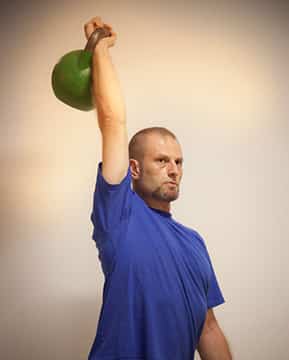
SPECIAL GUEST POST FROM SPYRO – certified kettlebell instructor!
I have a task for you: just go ahead and search the Internet for the term ‘kettlebells’. Then check out some of the resulting pages and I dare you not to think that these ‘cannonballs with a handle’ (a new banality is born every minute…) are some god’s gift to humanity.
I bet you are going to read stuff promising you serious muscle building, core strengthening, fat ‘torching’ and tremendous conditioning. There are also going to be some references to old school Russian strongmen eating iron nails instead of spinach, the infamous Spetsnaz, and – who knows? – maybe even Rasputin and Stalin too!
Well, let me tell you a little secret: not everything about kettlebells is exactly as advertised! And who better than a kettlebells coach to make this clear?
Kettlebells: what’s wrong with this picture?
Think of it this way: kettlebells are marketed mainly to the fitness crowd, people who ‘work out’ as their main physical activity. Their ‘sport’ is working out at a gym or at home, a couple of times a week, maybe more, and what they need is quite simple: some muscle building, some core strengthening, some fat loss and some work for their cardio-vascular system. Do kettlebells deliver the goods to this target group? You bet! And frankly, I find conventional kettlebells training way more challenging and beneficial than running on treadmills, or dancing to the Zumba beat.
The problem arises when one tries to market kettlebells to athletes, as a tool that will help them enhance their performance. Let’s take boxers, for example: if it is only muscle building, fat loss, core strength and conditioning they will find in kettlebells, i.e. general physical attributes, why would they bother? To those ends, boxers have been skipping rope, hitting bags, pads and sparring partners, doing roadwork, lifting weights and doing calisthenics since… forever! Why change what they have been using successfully for so many years?
You don’t fix something that is not broken: it would seem like a no brainer, but check out the training programs kettlebells coaches suggest as suitable for boxers and you will only see (anaerobic) conditioning programs: snatches alternated with burpees or push-presses alternated with chin-ups for a prescribed number of rounds, and so on. Well, I’ll tell it like it is: this training is good, but there is nothing special about it – it’s just generic conditioning. Even more, snatches and push-presses can just as well be performed with dumbbells! Our question remains then: what can kettlebells training do for boxers?
Sport-Specific Training For Athletes: Have Fun, Save Time!
As a physical preparation coach for combat sports athletes, I’m all about specificity in training and making the athlete’s life easier. Let me give you an example: if it is aerobic fitness a boxer wants to improve, why do roadwork (slow, long-distance running) when he can do boxing-specific activities (shadow boxing, hitting the pads or the bag, etc) for the same amount of time, while maintaining a heart rate of 130-150 bpm? This way the same physiological adaptations can take place (increased cardiac output and developed vascular network) and boxing technique can be trained at the same time.
We should always keep in mind that athletes took up boxing because they like to box, not because they like to spend hours at the track or practice exotic conditioning techniques with names such as ‘the rack’, the snatch’ and the ‘jerk’! So, to make it simple: when doing physical preparation training for athletes, do it in as much a sport-specific way as possible, so that both the athlete and the coach are happy.
Kettlebells For Boxers: What’s In It For Me, Then?
So, if the conditioning abilities of the kettlebell are ‘just OK’ for boxers, is there something about them which makes them exceptional for boxers? Sure there is! In my experience, kettlebells are by far the most suitable tool for highly specific exercises in order to increase power output in the key movements of the sport… Yep, it’s punching power I’m talking about!
Here’s why:
- Punching is a ballistic movement [1] par excellence (you launch your fists; you do not push with your fists). The big kettlebells lifts (swing, clean, snatch, push-press, jerk) teach power generation through ballistic movement. No other training method does that nearly as well, except for Olympic weightlifting, but…
- …an Olympic bar can only be used in bilateral movements and boxing movements are not bilateral. Kettlebells can be used from a staggered stance and give themselves very well to unilateral and contra-lateral (rotational) movements, such as the ones found in boxing.
- Kettlebells can provide training for the specific type and speed of muscular contractions used in boxing, namely starting strength for the upper extremities, accelerating and stretch-shortening strength for the lower body [2].
- All the kettlebells pulling exercises (swing, high pull, clean snatch) require dynamic hip extension performed repeatedly. Hip extension is the most important component in generating punching power, which has been greatly overlooked due to a ‘cultural’ attachment of combat arts with rotational movement (no, you do not need twisting sit-ups to punch hard!).
- The correct way to grip the kettlebell handle in positions such as the rack or the overhead lockout promotes the correct wrist alignment and the rigidity of the joint that will allow for a full transfer of the power of a punch into the target. During exercises such as the clean and the snatch, a big chunk of cast iron, moving at high speed with significant momentum, has to be stopped at just the right moment in the rack or overhead lockout position, so kettlebells can teach both the correct way and the correct timing of the wrist lock. Performing snatches or presses with a dumbbell won’t help with any of that.
Check out the video above to see just a few of the exercises that can be used for dramatically increasing punching power.
Please keep in mind that the exercises shown in the video are suitable for athletes who have already developed the minimum degree of range-of-motion and strength required to properly execute the techniques of boxing.
This means the exercises are NOT recommended for beginners. Also, a basic level of proficiency in the safe execution of the basic kettlebells exercises (two- and one-arm swing, clean, snatch, press and push-press) is necessary before trying to perform some of the more complex variations in the video.
Don’t believe the hype…
The purpose of this article was to point out that, marketing kettlebells exclusively as a training tool for conditioning simply does not do them justice, making them appear one-dimensional and limited in scope. While kettlebells are more than adequate as a training implement in order to improve a boxer’s physiology and energy systems, it is through enhancing striking biomechanics that they can provide the most impressive results inside the ring! Go ahead and try them and make sure you let me know what you think!
[1] A ballistic movement is a forced movement initiated by muscle action, but continued by the momentum of the limbs.
[2] For a better understanding of explosive strength, rate of force development, starting, accelerating and stretch shortening strength, plus the best methods to train these attributes, I highly recommend the book Understanding Physical Conditioning: A Movement Based Approach, by Luis Preto MSc.
Spyro Katsigiannis is the founder of the Dynamo Concepts training methodology, for teaching martial arts and enhancing athletic performance (www.dynamoclub.se). He is a certified Kettlebell Systema Coach under Denis Kanygin and a San Shou (Chinese kickboxing) coach. He offers consultation to combat sports clubs in biomechanical optimization of movement and power generation enhancement.
You can leave comments for Spyro below and he will answer them.





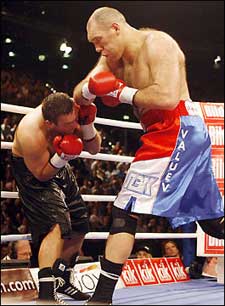
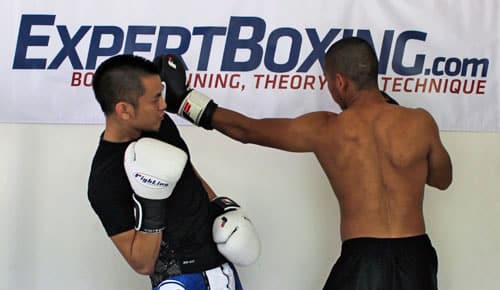
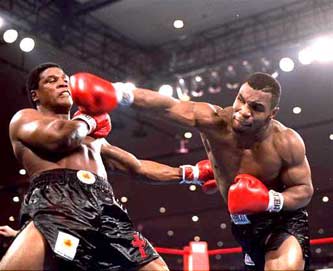


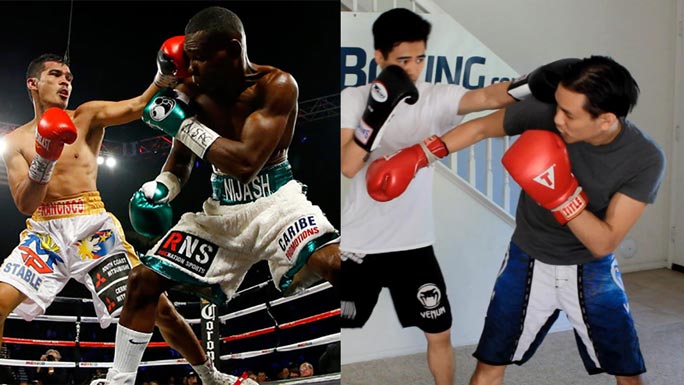
How many series and repetition in series? Any more drills?
I forget to thank you. As always, great article.
Sergio, the first couple of exercises are warm-ups and I usually do them in sets of ten – two, maybe three of them. For the explosive exercises, you can use basic power or speed training protocols (low reps, medium-high number of sets, 3-5 minutes of rest or more between sets). Whenever your speed of execution becomes less than maximal due to fatigue, you want to put the bells down and rest.
Regarding more drills, the key movement patterns you want to enhance is one, so not that many exercises are necessary: three per training session are more than enough.
Many thanks !
should i wear my cup while working through these?
(two- and one-arm swing, clean, snatch, press and push-press)
Appreciate if you recommend any youtube video for the above basic K.B boxing beginner exercise?
Hey Richard,
Check out this instructional video by Valery Fedorenko. Valery’s instructional skills are not the best out there, but I cannot think of any other video including all the basic lifts.
http://youtu.be/w2m6a-pSdxM
For the two-arm swing, check this one out:
http://youtu.be/UyHyIafGbCY
These are some great videos. So many many things I’ve never seen before. Thanks, Spyro.
Excellent article. Makes me realise I go to my kettlebell a little too often perhaps.
Next up – the Bulgarian training bag? Got a homemade one that is also lots of fun to play with!
keep up the excellent work
Rod
As a certified personal trainer, and a person who has investigated Russian Kettle-bell certifications, I can tell you two things confidently;
1. Sports specific training can NOT be the only way that an athlete trains. Non-linear training allows for the development of proprioception, and an decrease in overuse related injuries. The most successful athletes; such as Donald Driver, step out of their sport specific training to gain the benefits from not only training a muscle in a different way, but also to create other kenetic chains to utilize in their sport.
2. The video you are showing is not proper use of a kettle-bell. There are only TWO movements in the R.K.C. They are the kettle bell swing, and the Turkish Get Up. EVERYTHING in the kettle bell repertoire; The snatch, the press, the dead lift… is done off of one of these movements. It is treated very much like a martial art, and FORM is imperative to do the exercises safely (prevent strain related injuries) and get the most out of them.
By the way, I apologize if I seem like I’m “trolling.” I take my job, just as you take yours, very seriously. I have 22 years in the martial arts along with boxing, as well as 10 years in personal training. I really respect what you do and love almost all of the info that you provide.
Much respect to you as well. Thanks for stopping by.
Hey Robbyrob,
Thank you for your comment.
The ratio of GPP to SPP for athletes is a matter of great debate among sports coaches. For example, Anatoly Bondarchuk, hammer throw bronze medalist in the 1976 Olympics and probably the most accomplished hammer throw coach of all time, claims that athletes should be doing sport specific training almost exclusively. Since he has trained a number of champions, I will seriously consider what he says…
One question: who is the RKC coach who certified you? Did he teach you that the deadlift is done off of the swing? Are you sure it is not the other way around???
I am not sure what exactly your argument is here…
Hey Spyro my name is Dimitris and I live in Greece. I d like to start boxing.. I live in Athens. Do you know any good boxing club to start here? Coaches here dont pay a lot of attention and I m looking for something good.. My email is [email protected]
Thanks a lot
I thought the RKC minimum had those two exercises (swing and turkish get up), and once you get proficient enough with them you can move on to “the real” RKC?
Kettlebell swings make my balls hurt inexplicably. Any suggestions why this happens? And no i’m not trolling, i’m dead serious.
Is there contact between the bell and your testicles involved?
lol……maybe that’s it. I’ll try not to bounce them off my nads next time.
But seriously, no contact…..I just feel like a “click”, like a string just snapped.
Lol….it’s kind of annoying.
Ian, does the same thing happen when you perform a slow, controlled deadlift?
Don’t know but i’ll see.
And Saber Khan, that’s a scary thought. I hadn’t thought of that before.
Although, it’s not like a prolonged heavy lift. So I can’t see it being the case. Either way, something to think about.
I mis-read your post. No, I’ve done deadlifts recently, and this has never happened during deadlifts.
Ian, if you can deadlift heavy with no testicular pain, then most probably you do not have a groin hernia – of course, the best thing to do is check with a doctor on this.
dude its very likely youre prone to a hernia, better have it checked out
I trained olympics weightlifting and power lifting 20 years ago(1 year olympics-6 years power lifting), I know what explosiveness is and how to aply it to my new sport(boxing) which I been practicing for 2 years till now, I don’t see the point on training with these balls when there are so many other options, less technical and also less dangerous, because this balls emule the olympic training and it is very very technical, so improper practice will for sure damage your body. As Jhony said in another article, you can use the rubber bands(punching), push ups(explosive), and so many other exercises less technical.
However if you decide to use the balls, better learn how to use them properly. Nowdays everyday goes out a new hip in training methods, so learn about them, inform yourself and make a choice.
Of course it’s only my opinion, I been retired of high level performance in bodybuilding for nearly 13 years and today I’m just fine with a good cardio condition, good body looks, and mid level boxing(jajaja, so I say).
Anyway good article, good luck to everyone!
Hey WhiteCollar,
I agree with you that kettlebells lifting is quite technical and, if performed improperly, might result in injury. Still, the benefits in pure power generation outweigh by far the small commitment required in order to learn proper technique.
Regarding explosive push-ups, they are a great generic exercise, not a sport-specific one – the push-up movement is in no way similar to any movement in boxing (or any other sport).
Rubber bands promote a different type of muscular action than kettlebells. The more a rubber band is elongated, the more resistance it provides, simulating what an athlete’s muscles might do when he is pushing a resisting opponent out of the ring (or pushing a car uphill). Punching requires ballistic movement, i.e. momentary tension that fuels the rest of the movement: tension immediately followed by relaxation.
A very good tool to promote ballistic movement is the medicine ball. Still, one can perform med-ball rotational throws with bad biomechanics: for example if the rotation happens in the lumbar spine, instead of the hips and the thoracic spine, there will be power leakage and quite probably, lower back injury will happen. Lifting kettlebells teaches both ballistic movement and forceful hip extension, so in this sense, the KB is both a training implement and a ‘teacher’ of correct biomechanics, so to speak. Of course, other complementary training methods should be used to achieve the desired results.
Finally, kettlebells have been used by strongmen since the end of the 19th century, Soviet athletes (wrestlers, boxers and track&field) utilize them since the 1950s, and they were introduced in the Western world back in the late 1990’s, so I wouldn’t say they’re the latest training fad 🙂
i love the way you broke this down, i like how you saved us time by defining the word, helps for better understanding 🙂 good job professor Johnny Nguyen, i learned something about kettle bells, but i also learned to better understanding my boxing techniques and form
what weight would you recommend using? I know this is down to the individual so i’m 5’10 weigh 64kg before i started boxing about 8 months ago i used to go to the gym a lot, i used dumbells more than the bar and would chest press 26kg (each arm) shoulders about 18, curling 14 and lat raise with the bar about 45/50. I train hard (boxing). Thank you for this article and the video, very much appreciated
Hey Ritchie, thank you for your comment.
For the warm-up exercises (until 0.46) start with 12kg and move up to 16kg when you feel comfortable. For the explosive lifts (0.46 – 2.10), try a weight that allows you to perform a short, sharp initial muscular contraction that will ‘fuel’ the rest of the movement. If you need to maintain the muscular action for the whole movement, it means that the weight you’re using is too heavy. For the grinding lifts at the end of the video, you can go medium (8-12 reps) or heavy-ish (3-5 reps) with the One-leg Romanian Deadlift, and medium with the Supported (Renegade) Row. Make sure you know how to use the kettlebells safely and with proper technique before you attempt any of the explosive exercises.
Hi Master John, great articles, always well written and so real.
I just wanted to remind you that you still haven’t write on SHADOWBOXING, I just wonder, such a good exercices and master john doesn’t write about it. Whatever, Your the capt’n on this ship, I understand that time goes fast and you got your life to live.
But if you could write an article about shadowboxing, I’ll be your first reader. Cuz as an Ali fan like I guess everybody on this site I think that is nearly the best after sparring to working on your movement.
Training to fly like a butterfly and to sting like a bee.
But keep on doing how you feel I just love thoses articles, they helped a lot visualize what boxing is all about. Much respekt, from Switzerland
The shadowboxing guide is on the way, Joaquim. Shadowboxing is indeed very important and must be done right!
Thanks for posting this Johnny, I think there was allot of confusion around your heavy lifting articles in regards to Boxing conditioning. Lifting weights is great for conditioning the joints and muscles providing its done correctly (it’s also good for those how are prone to injury or who are recovering from injuries – rehabilitation exercises). I lift weights for my nerve damage, and its done wonders for my boxing game.
I’ve fit this into my routine. So far it’s made me more conscious of my hips. Technique-wise (kb swings) i’ve had an instructor tell me to straighten my hips n legs more and explode faster off the swing.
Tried it and i feel like i relieve weight from under my feet as the movement is executed, is this a lapse in technique or is this right?
Hey Shilmar, thank you for your comment. I do not quite understand what you mean by “i feel like i relieve weight from under my feet as the movement is executed”. Could you please elaborate?
Yes, when you are first learning the KB swing technique, it is quite important to dynamically extend both hips and knees. Down the road, you can make the extension movement somehow softer.
Well my way i started doing it was to lower my center of gravity and keep it lowered even at the top of the swing. Seems hard to when i fully extend my hips (hence relieving weight from under my feet), am i supposed to?
Shilmar, the movement of the basic KB swing is pretty much similar to an upward jump (like when you’re trying to touch the rim), so you should extend both hips and knees dynamically. If you perform what is known as the ‘triple extension swing’ (extending the ankles too) you should feel as if your weight is ‘relieved’) otherwise keep your weight towards your heels. In any case do NOT keep your center of gravity low in the top position of the swing.
Denis Kanygin..Science of Kettllebell Sport. ..Clear/ Informative.
He suggests leaning back during lifts. Others i have viewed don’t seem
to mention this directly…others seem to indicate a bent arm high-pull
to maintain a vertical path…Your opinion?
Hey John Mastro,
Thank you for your comment. Denis is my instructor (I am certified under him) and I believe that his instruction is top notch.
If you want to last for ten minutes under the kettlebell/s in girevoy sport, you absolutely have to lean back in the clean and the snatch lifts. In two kettlebells lifts you lean back, while in one-handed lifts you lean both back and towards the opposite side of the working hand. In explosive lifts from the floor or the dead hang, you lift straight up by jumping and shrugging, just like in Olympic weightlifting.
Nice! “God’s gift to humanity” is right! It’s really cool to see more and more people realizing just how beneficial the kettlebell can be, and I think you’ve got some great ideas focusing workouts for boxing athletes. Keep swingin!
gooday
am Nigeria amateur bantam weight champ i want u to get me a manager
that will work on my visa to your country i need your cell phone number
am just 21 yrs of age i have loss my parent i need you help nice i
want to turn to a pro boxer under your banner
meeting you
best regard
my mobile…+2348024201707
[email protected]
my link. http://www.doghouseboxing.com/Jason/Petock1030a09.htm
I dont get the russian refrence hahaha
Bless!
I am communicating interest to have you visit our Club, and would like details regarding retaining your consultation for a 1 Day Professional Athlete and Coach Clinic.
Please let me know your thoughts and have a beautiful week?
What do you think about kettlebellSport?
I have noticed that athletes in that sport look weak like they do not use muscles but swings instead. Don you recognise kettlebellSport as a Sport?
Too slow. The person is movi nbg the weight too slow to benefit from punching power. He needs to move it much faster. There is no difference between a normal dumbell weight session and what he’s doing.
Hi,
I am jack, Thank you for giving us knowledge about, how to increase the strength of our punch with kettlebell & with other exercises.